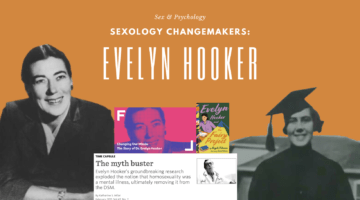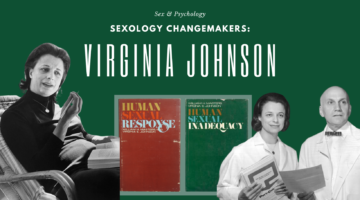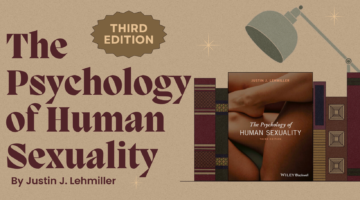Learning More About Asexuality: “Sounds Fake But Okay”
May 22, 2024 by Emily Mendelson
In 2020, The Trevor Project conducted a national survey of over 40,000 LGBTQ youth, in which they found that 10% of respondents identified as asexual or on the ace spectrum. This number is much higher than the estimated percentage of sexual minority adults who identify as asexual (1.7%), which suggests that ace identities are on the rise among young adults. Although public awareness of asexuality has grown in recent years, it continues to be one of the most-misunderstood sexual identities.
A recently-published book, Sounds Fake But Okay, helps to illuminate the experience of individuals on the ace spectrum. Authors Sarah Costello, who is aro/ace, and Kayla Kaszyca, who is demisexual, describe the book as “an asexual and aromantic perspective on love, relationships, sex, and pretty much anything else.” Their book emerges from their podcast, also titled Sounds Fake But Okay, where the two chat weekly to discuss all-things related to love, sexuality, and relationships from an aromantic asexual and demisexual perspective. Below, we’re going to discuss some key concepts from their book and some of the myths that it dispels about asexual individuals.
Defining Asexuality
Before the book begins, readers are presented with a helpful dictionary of terms related to asexuality (ace), which is defined as the experience of little to no sexual attraction. Notably, sexual attraction is “not the same as a sexual desire or a person’s libido. Rather, it is who you are or are not attracted to” (p. 8). Other definitions provided include, but are not limited to:
- Allonormativity: the belief that all people are and should be allosexual (experiences sexual attraction) and alloromantic (experiences romantic attraction)
- Demisexual: the experience of sexual attraction once a romantic or emotional bond is formed
- Aspectrum: an umbrella term for identities that fall on the asexual spectrum and/or aromantic spectrum
After these definitions, the prologue to the novel introduces Sarah and Kayla’s love story – which is (for them), the “greatest love story of all time” (p. 10). As the authors are in neither a sexual nor romantic relationship with one another, this theme of subverting expectations of what love should look like becomes more apparent with each chapter. That is, a fundamental aspect of understanding asexual experiences is adopting an “aspec lens” (p. 28) to life, society, and relationships.
The idea of this “aspec lens” is introduced in the first chapter of the book, Society. An asepc lens is a way of approaching the world with “eyes wide open” and rejecting the premise that we should do something because “that’s the way this has always been” (p. 28). The necessity of adopting this lens emerges as particularly important throughout the middle of the book, specifically in Chapter 3, Friendships, Chapter 4, Relationships and Partnerships, and Chapter 5, Sex.
Adopting an Aspec Lens
Using an aspec lens when approaching relationships helps individuals to think about their life and relationships in ways that they may not have previously considered. As Sarah and Kayla explain:
Our society tells us that there is a clear ranking of importance in the types of relationships any human has, and in this ranking, the romantic-sexual relationship always comes before the platonic. In this ranking, other variables do not matter (p. 51).
Despite this relationship hierarchy that is ingrained within our lives, an aspec lens would challenge that romantic-sexual relationships should or would supersede the intimacy within a close friendship. Although adopting this lens may be easier said than done, the authors provide plenty of examples and give an introduction to queer-platonic relationships as a way to give readers an alternative picture of intimacy that they may be unfamiliar with.
An aspec lens subverts traditional relationship expectations, but it also challenges a litany of myths about individuals on the ace spectrum. Briefly, a few of the myths that Sounds Fake But Okay debunks are:
- The idea that aspec people are lonely. Rather, choosing to live alone romantically and being lonely are not synonymous with one another.
- The idea that aspec people do not desire intimacy with others. Depending where an individual is on the ace spectrum, “asexual people can be and are in romantic relationships” (p. 66), and often thrive within them.
- The idea that aspec people do not have reasons for having sex. In reality, there is a spectrum of sexual desire. The authors present a scale that ranges from “sex-repulsed → sex-averse → sex-indifferent → sex-favorable” (p. 90).
In addition to myths behind friendship, relationships, and sex, the book also discusses aspec individuals’ experiences with family (chapter 6), gender (chapter 7), and themselves (chapter 2). These chapters provide a well-rounded insight into what it means for one to live life on the aspec spectrum. This book has value not just for individuals who are aspec, but also for individuals who simply want to learn more as well.
Continue Learning About Asexuality
Each chapter of the book is accompanied by a podcast episode that Sarah and Kayla recorded to speak more deeply about the subject (accessed with a QR code/link at the end of each chapter). These chapters and episodes contain not just their own stories, but narratives of other individuals on the ace spectrum who have written-in about their experiences. Readers can anticipate a diverse range of perspectives from individuals all across the ace spectrum, as well as those with different gender identities and ages.
To learn more about asexuality, check out the Sounds Fake But Okay podcast, The Trevor Project, The Aro and Ace Advocacy Project, the Asexuality Visibility and Education Network, and Ace Week. You can also check out our podcast episodes with Dr. Malvina Skorska and Dr. Morag Yule for a deeper dive into asexuality research.
Want to learn more about Sex and Psychology? Click here for more from the blog or here to listen to the podcast. Follow Sex and Psychology on Facebook, Twitter (@JustinLehmiller), or Reddit to receive updates. You can also follow Dr. Lehmiller on YouTube and Instagram.
Image Source: Banner made with Canva

Dr. Justin Lehmiller
Founder & Owner of Sex and PsychologyDr. Justin Lehmiller is a social psychologist and Research Fellow at The Kinsey Institute. He runs the Sex and Psychology blog and podcast and is author of the popular book Tell Me What You Want. Dr. Lehmiller is an award-winning educator, and a prolific researcher who has published more than 50 academic works.
Read full bio >


